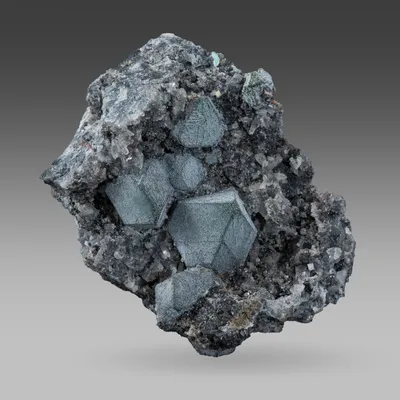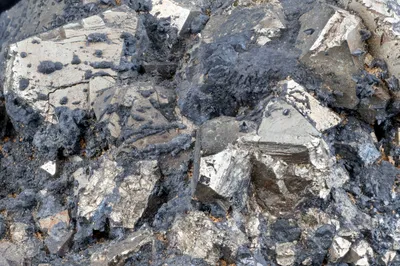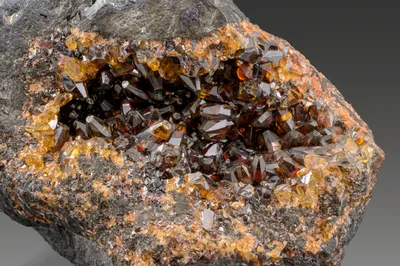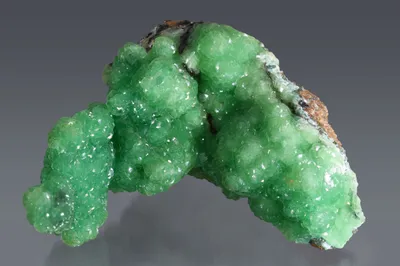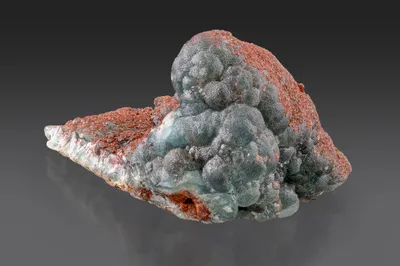Mineral Species
Hematite
Type Locality
No
Composition
Fe2O3
Crystal System
Trigonal
Status at Tsumeb
Confirmed
Abundance
Somewhat rare
Distribution
First, second and third oxidation zones
Paragenesis
Supergene
Entry Number
Species; TSNB163
General Notes
Hematite is somewhat rare at Tsumeb which is consistent with the relatively iron-deficient nature of the ore body (please refer to the goethite section). Well-formed crystals of hematite are especially uncommon. A tendency to confuse hematite with goethite, or even with undifferentiated iron oxides ("limonite") is noted.
The earliest mention of hematite sensu stricto appears to be by Strunz et al. (1958a) who recorded the presence of rosettiform hematite in the second oxidation zone.
Bartelke (1976) noted the rare occurrence of hematite as black crusts or as tiny lustrous red crystals.
Pinch and Wilson (1977) reported hematite as "… black crusts of very small, sometimes translucent, red, lustrous crystals", as "… botryoidal 'kidney ore'", and as "… octahedral 'martite' pseudomorphs after magnetite to about 1 cm in size."
A specimen from the Pinch collection (MGMH 2020.7.0703) comprises platy crystals of hematite (to 1.5 mm), associated with brunogeierite, stottite and Zn-bearing siderite on germanium-rich sulphide ore from the second oxidation zone. Pseudomorphs of hematite after pyrite are also recorded in this paragenesis.
A second specimen in the Pinch Collection (MGMH 2020.7.3291) consists of platy, striated crystals of black hematite, partly encrusted by rosettes of sub-mm discoidal siderite crystals. The siderite is Ni and Zn bearing (each to approximately 3.3 mol %) and the specimen is from 44 Level in the third oxidation zone.
Microcrystals of hematite are sometimes associated with willemite, both as inclusions and as dustings on the surface of crystals and crystal aggregates. Examples from the collections of Brent Thorne and Simone Citon are figured on Mindat (www.mindat.org/gallery.php?loc=2428&min=1856; accessed January 2023).
Keller and Bartelke (1982) recorded the discovery of "… brilliant black crystals of mimetite up to 1 cm tall … in an unusual intergrowth with reniform masses of hematite. A core of mimetite is overgrown by hematite which is partly or completely covered by a second generation of mimetite" (see mimetite section).
Finely divided iron oxide, probably hematite, is commonly included in calcite from Tsumeb, imparting an attractive reddish-brown colour to the crystals.
Associated Minerals
alamosite; anglesite; arseniosiderite; arsenogoyazite; bayldonite; brunogeierite; calcite; calvertite; cerussite; conichalcite; connellite; dolomite; duftite; fleischerite; fraipontite; galena; gallobeudantite; gebhardite; gerdtremmelite; hemimorphite; kaolinite; kegelite; leadhillite; ludlockite; magnetite; mathewrogersite; mawbyite; melanotekite; mimetite; minrecordite; ojuelaite; philipsbornite; plumbotsumite; pyrite; quartz; renierite; schneiderhöhnite; scorodite; siderite; smithsonite; stolzite; stottite; tsumcorite; willemite; wulfenite; zincolivenite
Pseudomorphs
Hematite is reported to form pseudomorphs after the following minerals: magnetite (rare); pyrite (rare).


